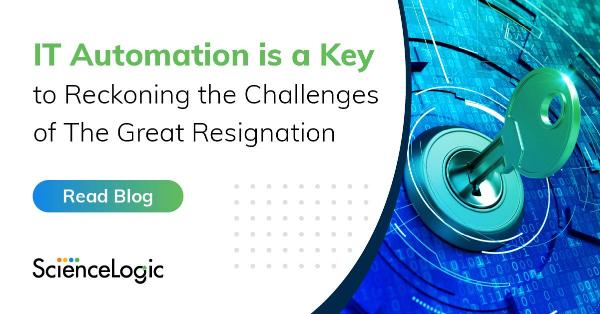IT Automation is a Key to Reckoning the Challenges of The Great Resignation
To better understand the reasons why, Pew Research surveyed people who had quit as part of The Great Resignation and found that, while the top reason (63%) was low pay, other factors played a big part in causing people to walk away in search of a better opportunity, including:
- No opportunities for advancement (63%)
- Felt disrespected (57%)
- Child care issues (48%)
- Lack of work hour flexibility (45%)
- Unhappy with benefits (43%)
Whatever the reason, when individuals take measure of their circumstances and how their employment situation fits into their quality life and career goals and decide to walk out the door, the exodus of skilled labor puts business operations at risk. Loss of tribal knowledge, capacity, and availability—and an increase in human error as new workers take the place of old—results in reduced productivity and quality. That can put unprepared organizations in a death spiral as employees and customers leave.
A Tech Strategy for Addressing The Great Resignation
Business leaders who recognize that fixing the problems created by The Great Resignation go well beyond simply recruiting new talent and increasing pay are looking to technology to protect their operations. Strategic investments in modernized IT infrastructure can address an operation’s capacity, productivity, and availability, but also contribute to a better, more respectful, and satisfying work environment for employees.
A key component of this transformation is the adoption of IT automation to tackle the simple, repetitive tasks that can take too much time from an employee’s workday. Such routines serve to keep employees tied to daily drudgery rather than use their skills and creativity in ways that are more professionally fulfilling, and that add value to their organization. The irony here is that automation is often demonized as a job-killer; every task automated is a way for overbearing micromanagers to reduce headcount and enrich themselves and their shareholders.
Automation Isn’t the Problem, It’s the Solution
In reality, IT automation is merely a tool that drives repeatable and predictable processes with consistent quality and, in turn, makes an organization’s people more productive. That is why, even before the advent of The Great Resignation, forward-thinking organizations had already begun investing in digital transformations to enable broader implementation and more sophisticated levels of IT automation. And while the goals of each organization may be different, to get there, they follow a consistent roadmap:
- Invest in infrastructure reliability (scalable, elastic, secure)
- Build a centralized knowledge infrastructure (monitoring, CMDB, orchestration)
- Establish an operational data lake with a common data model
- Adopt automation-enabling technologies (AIOps, software modules, ecosystem integrations)
- Follow a proven maturity model to build trust:
- Start simple, and incrementally increase sophistication
- Build IT workflows based on trusted, accurate data
- Leverage human capital and tribal knowledge for the most critical workloads
Using this approach, and with an AIOps platform as the basis for monitoring all elements of the IT estate across the entire infrastructure—including on-premises and cloud infrastructure—and providing necessary machine learning analytics, IT teams can better leverage even legacy systems to extract maximal value from existing systems and future IT investments. Intelligent ecosystem integrations, backed by complete and trusted data, provide the necessary context for automating operational decisions, including troubleshooting and predictive maintenance, to increase the health, availability, and reliability of the IT estate.
An Investment in Automation is an Investment in People
This is a critical element to protecting operations. Fact is, as IT infrastructures have accelerated in size, speed, and complexity, an overreliance on a primarily human workforce is fraught with risk. Even the most conscientious of employees are prone to fatigue, distraction, absence, and other factors contributing to human error. Skilled IT staff don’t want to perform repetitive IT tasks such as observing, monitoring, and updating configuration management databases. And they aren’t capable of keeping up with the pace of change inherent to today’s IT estate, in any case.
Today’s IT infrastructure is hybrid, traversing bare metal, virtual, and cloud systems, making those tasks impossible for people without machine support. Automation fills this need and frees up the company to invest resources in strategic innovation and higher-order priorities to capture market share. And for organizations facing the prospects of IT modernization and the threats associated with The Great Migration, improving IT performance and reliability translates to an opportunity to attract and retain a workforce that is fairly compensated, has an opportunity to grow and advance, and feels respected.

